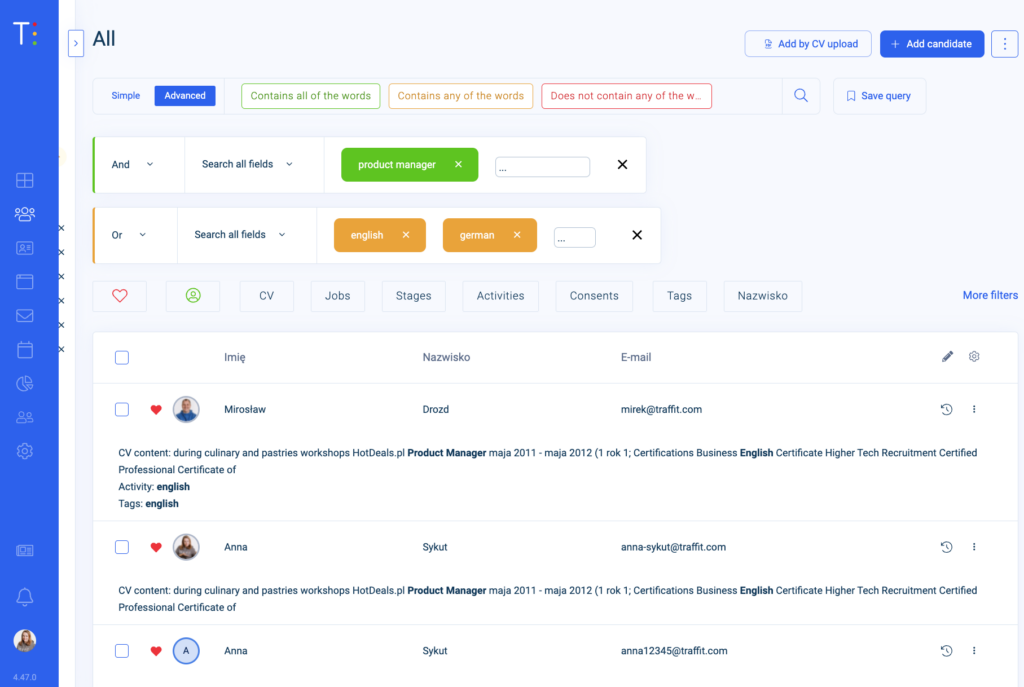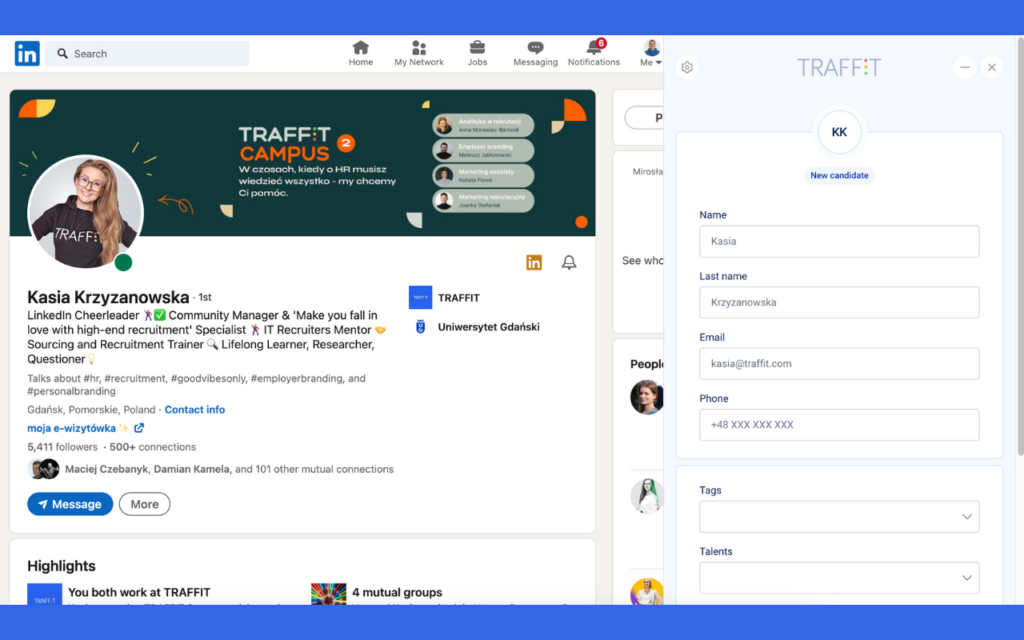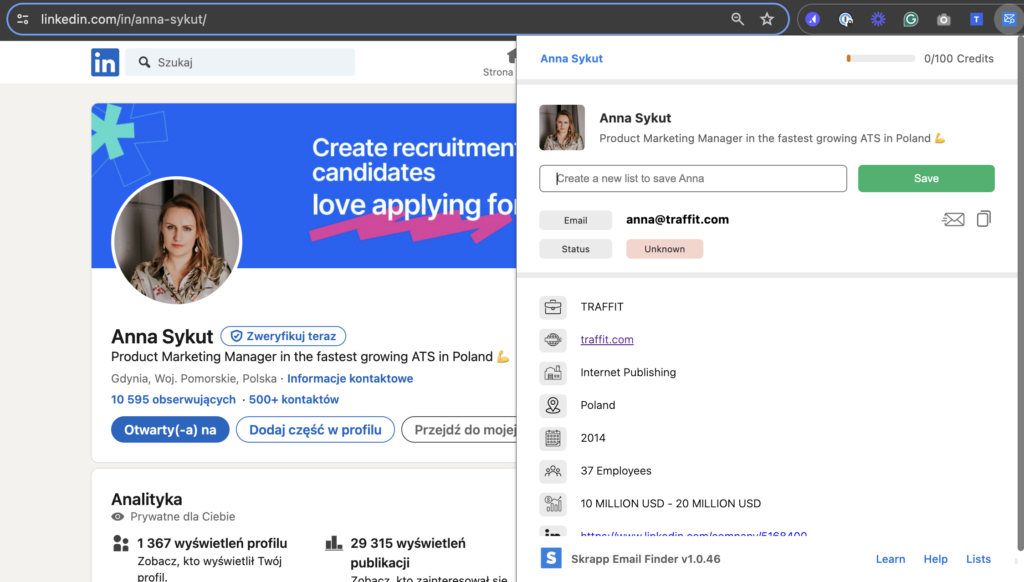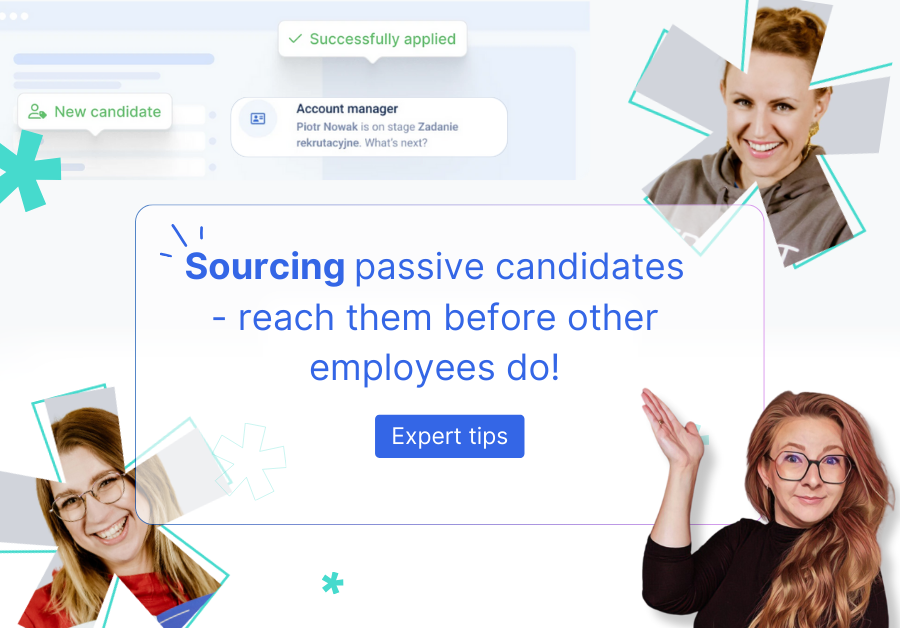Nowadays, when 80% of potential candidates are passive – hiring the best person for the job requires going ‘upfront to candidate’ by talent sourcing.
But where and how to do it?
Thanks to this article you will learn:
What is talent sourcing?
Where to source candidates?
What tools support talent sourcing?
How to write a good sourcing message?
Let’s go!
What does talent sourcing mean?
Kasia Krzyżanowska, Community Manager at TRAFFIT, will explain it to you!
Talent sourcing is a process. And this is basically where we can start the real description of it. Because sourcing is not just an activity, it is not just a shuffle to be done. Sourcing candidates is a lifestyle 😀 And quite seriously, sourcing is more than finding and reaching out to candidates. It’s a whole strategy of activities focused on the candidate, their motivations and needs, contact, and building relations.
Speaking about talent sourcing, we should focus on actively seeking and engaging potential candidates for specific jobs. By sourcing candidates, we focus on those, who do not actively apply for job offers but may be interested in new career opportunities. We call them passive candidates.
Talent sourcing strategy goes beyond traditional job advertisements. It uses advanced tools and techniques to help identify Talents. It is based on social media searches, databases, industry forums, and other specialized platforms. Sourcing allows you to build relationships with passive candidates even before a specific recruitment need arises. This in turn reduces the time it takes to find the right person for the job and increases the quality of the processes.
Sounds serious, huh 🤩 So let me tell you where you can source candidates!
Where can you source?
Candidate sourcing can take place on several platforms, depending on the type of talent or skills you are looking for.
✅ For IT jobs, it is worth focusing on portals such as GitHub or Stack Overflow, where professionals share their projects and technical knowledge.
✅ For creative professionals: platforms like Behance or Dribble can be key to finding the right portfolio.
✅ LinkedIn, on the other hand, remains a universal tool for many industries, offering wide access to professional profiles from different sectors. In addition, you can source on Xing (candidates from Germany, Austria, Switzerland).
✅ Social media will also provide us with a wealth of knowledge: Facebook, Instagram, TikTok or X (Twitter).
✅ We can identify the circles of interest of our potential candidates thanks to MeetUp or Polywork (a slightly older novelty – a service that shows that you can build a multidimensional picture of your career and makes the diversity of experiences, skills, and passions visible. The platform promotes the idea that careers don’t have to be linear and that different experiences and projects can be valuable, even if they don’t fit into a single career path) – helpful for creative careers and finding multi-talents 💪
💡 Let’s remember one thing in talent sourcing – an ethical approach.
Information can be found everywhere. However, it is important to use it in accordance with the applicable law.
We already have a candidate, but what will make us stand out positively? Communication!
A personalized approach is key. Rather than sending mass messages, take the time to understand the person’s professional profile and tailor the message to reflect an interest in their experience and skills and – importantly! – motivations. Yes, that’s right, motivations.
Before writing to potential candidates, it’s worth considering what motivations they might have for changing jobs. And how can our offer respond to those motivations? Such a strategy not only increases the chances of a response but also builds a positive employer image in the labor market.
Our LinkedIn profile is not for us, but about us. The job offer is made for candidates. We should write the messages thinking about them.
The role of the sourcer is not just to find the candidate. The role of the sourcer is to invite them to the process, and this can heppen only through good communication.
What tools support talent sourcing?
To start talent sourcing, all you need is the knowledge Kasia shared in the previous paragraph – but there are tools that make the process easier.
The first one is a good ATS (applicant tracking system). Why? You need the space to store the data of the candidates that have been sourced, and which:
- allow candidate’s data to be processed securely and shared conveniently with the rest of the team,
- make it easy to search for such talent later on, e.g. by skills or assigned keywords (tags),
- it will make it possible to analyze the effectiveness of sourcing – e.g. show how far sourced candidates have progressed in the process and where sourcing has most often resulted in employment.
The ATS performs all these functions superbly, allowing in addition to source candidates in your talent pool. Sometimes we forget the talents that are already there and there is no need to start searching “outside”
This is how an advanced search engine (boolean – with AND, OR, and NOT operators) looks like in TRAFFIT:

The second tool worth mentioning is the TRAFFIT sourcing plugin. It is compatible with the ATS, so you only need to install it in your Chrome browser to be able to add sourced candidates to your candidate database directly from your browser.
This is a very convenient method to quickly:
– add the candidates and their data (including consents) to the database,
– assign keywords (tags) to them,
– add notes,
– assign them to a specific job.
The ATS system will automatically collect and save information on who sourced the candidate in question and on which website they were added to the database:
.

Last but not least – Skrapp plugin. When browsing a potential candidate’s profile, e.g. on LinkedIn, activating the plug-in results in a search of the Internet resources for an email address for that person:

Using this plugin is free of charge (there is a limit of 100 credits per month). You can also try the E-mail finder option, available free of charge here.
How to write a good sourcing message?
Here are 5 tips for writing a sourcing message that will convince a candidate to respond from Anika Osmólska, Head of People & Culture at TRAFFIT:
1. Quality over quantity.
The most common complaint about recruiters writing to potential candidates is that they did not read their profile thoroughly before sending the message. This is because recruiters want to increase their chances of generating interest by contacting as many people as possible. However, in sourcing, one good message is of more value than ten offers with, for example, a name or a role wrong.
2. Personalize.
A good talent sourcing message is personalized as much as possible. Candidates immediately sense a mass email that they no longer write back to because they don’t feel it was addressed to them. Therefore, take the time to carefully read the profile of the person you want to write a message to and avoid the copy-paste method when sending a message.

Approach each person individuallly, refer to their role, write by name and add those elements that will immediately show that you care about contacting the person specifically.
In this way, you are sure to stand out among the bulk e-mails sent by recruiters.
In addition, a potential candidate seeing that you have put a lot of time and work into writing your message is more empathetic to not leave you without a response, even if they are not interested in the role.
3. Act patiently and with attention to the candidate.
Candidates who are undecided about changing jobs are unlikely to still be after one message from you. Such changes take time and pushing too hard will most likely backfire – the candidate will withdraw from the interview. Therefore, plan your communication into several stages that will gradually demonstrate the value of your offer.
Also, talk carefully to the other person and pay attention to what is important to them. More important than what you want to write is what the person needs and is looking for. If you can capture this and present it appropriately with your offer, the candidate’s interest in further conversations will increase.
4. Build relations for the future.
When sourcing, refusal to talk about an offer will be the order of the day and this is perfectly normal. However, when you hear that someone isn’t interested now, don’t see it as the end, but use it as an opportunity to build your prospect base. Show your understanding to the candidate and say that you are happy to stay in touch because you see this acquaintance as the start of a relationship, even if it has not worked out now.
Make it clear that the candidate may also contact you themselves if they want to change jobs, because there may be an offer available. It’s important to make it clear to the other person that they can get back to you at any time and not necessarily only about the job. This builds trust and increases confidence that the candidate will choose you in the future.
5. Nurture candidates.
Once a candidate has shown a desire to establish a relationship, plan to communicate periodically with that person. Ideally, messages from you should give that person value. For example, you can send webinars, and articles that are related to the candidate’s work. If the candidate is active on social media, respond to their activities.
This way, the next time a professional opportunity is on offer, you will be a trusted and known person who is more likely to be spoken to about the job offer.
Conclusions?
According to our recruitment benchmarks employees’ candidate database is the best source of applications, generating 28% of all hires. Therefore, collecting applications for specific positions should not be the only method of building a candidate base.
It is also worth enabling interested candidates to spontaneously add CVs to the database and investing in sourcing passive candidates.



